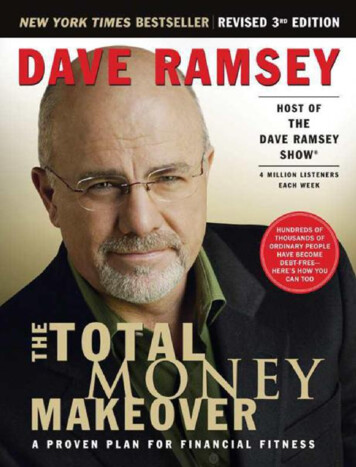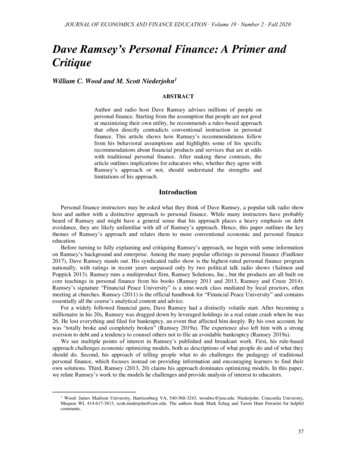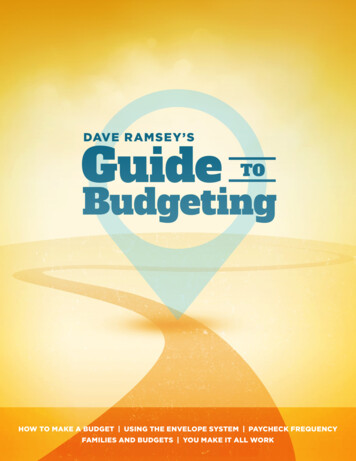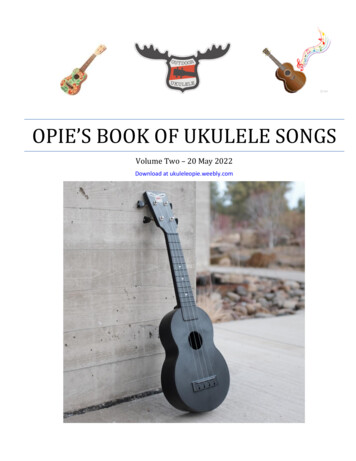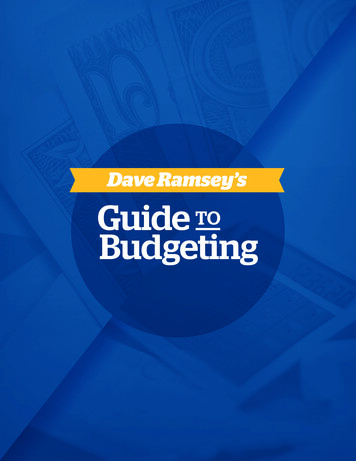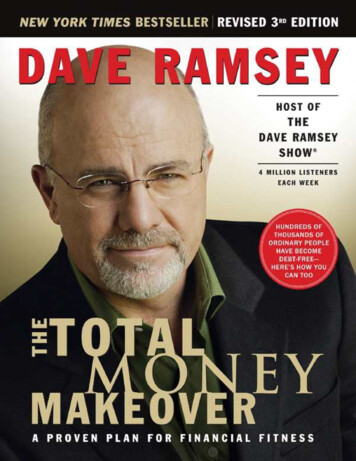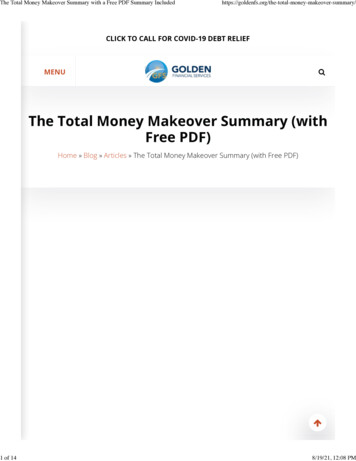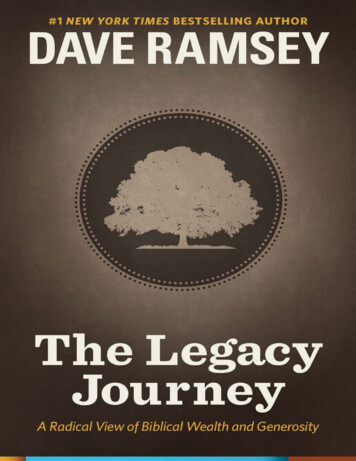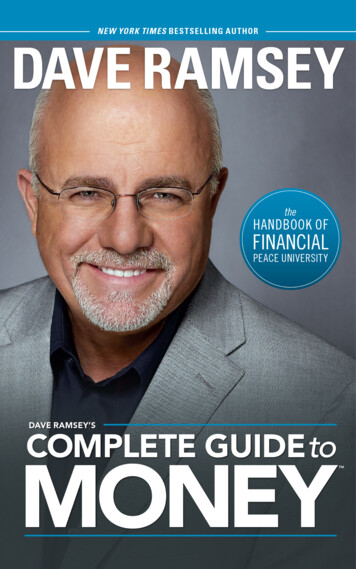
Transcription
DAVE RAMSEY’SCOMPLETE GUIDE TO MONEYThe Handbook of Financial Peace UniversityPeacePhilippians 4:7
2011 Lampo Licensing, LLCPublished by Lampo Press, The Lampo Group, Inc.Brentwood, Tennessee 37027All rights reserved. No portion of this book may be reproduced, stored in a retrievalsystem, or transmitted in any form or by any means—electronic, mechanical,photocopy, recording, scanning, or other—except for brief quotations in criticalreviews or articles, without the prior written permission of the publisher.The Dave Ramsey Show, Total Money Makeover, Financial Peace, Financial PeaceUniversity, and Dave Ramsey are all registered trademarks of Lampo Licensing,LLC. All rights reserved.Scripture quotations noted nkjv are from the New King James Version . 1982by Thomas Nelson, Inc., Publishers. Used by permission. All rights reserved.Scripture quotations noted niv 1984 are from the HOLY BIBLE, NEW INTERNATIONAL VERSION . 1984 Biblica. Used by permission of Zondervan. Allrights reserved.Scripture quotations noted niv 2011 are from the HOLY BIBLE, NEW INTERNATIONAL VERSION . 2011 Biblica, Inc. Used by permission. All rightsreserved worldwide.Scripture quotations noted nrsv are from the New Revised Standard VersionBible. 1989 National Council of the Churches of Christ in the United States ofAmerica. Used by permission. All rights reserved.Scripture quotations noted cev are from the Contemporary English Version . 1995 by the American Bible Society. Used by permission. All rights reserved.Scripture quotations noted The Message are from The Message. 2002. Used bypermission of NavPress Publishing Group.This publication is designed to provide accurate and authoritative informationwith regard to the subject matter covered. It is sold with the understanding that thepublisher is not engaged in rendering financial, accounting, or other professionaladvice. If financial advice or other expert assistance is required, the services of acompetent professional should be sought.Editors: Allen Harris, Jennifer Gingerich, Darcie ClemenCover design: Chris SandlinInterior design: Thinkpen Design, Inc., www.thinkpendesign.comISBN: 978-1-937077-20-412 13 14 15 16 C&C Printing 7 6 5 4 3
DEDICATIONTo the millions of men and women across the country whohave sat face to face and knee to knee with other families in Financial Peace University classes since 1994. Yourpassion, enthusiasm, and incredible successes are taking themessage of Financial Peace to new heights, changing behaviors, breaking generational trends, and restoring hope for ournation’s economy.To Louis Falzetti, executive vice president of Financial PeaceUniversity, who stayed late after class one night to help me stackchairs and hasn’t left my side in the sixteen years since. Yourvision for what FPU could become turned my small, local classinto a household name. Millions of families thank you—and sodo I.
ACKNOWLEDGMENTSWriting a book is a huge endeavor that goes far beyond thename of the guy on the cover. I’d like to thank the following people for leading the charge to make this book possible:Allen Harris, my editor for this book, for helping me turntwenty years’ worth of teaching, experience, and stories into amanual that anyone can use to win with money.Darcie Clemen, Grace Clausing, Blair Moore, and JenniferGingerich for providing editorial and project managementsupport.Daniel Bell and Chris Sandlin for overseeing all graphicsand cover art.Louis Falzetti, Debbie LoCurto, Paul Boyd, Beth Tallent,Oksana Ballard, Brian Beaman, Russ Carroll, Jack Galloway,Heath Hartzog, Darrell Moore, and Brent Spicer for reviewingearly drafts of this book to let me know what worked—andwhat didn’t.
TABLE OF CONTENTSINTRODUCTION . . . . . . . . . . . . . . . . . . . . . . . . . . . . . . . . . . . . . . . . . . . . . . . 11. SUPER SAVING:Common Sense for Your Dollars and Cents . . . . . . . . . . . . . . . . . . . . . . . . . 52. RELATING WITH MONEY:Nerds and Free Spirits Unite! . . . . . . . . . . . . . . . . . . . . . . . . . . . . . . . . . . 253. CASH FLOW PLANNING:The Nuts and Bolts of Budgeting . . . . . . . . . . . . . . . . . . . . . . . . . . . . . . . 534. DUMPING DEBT:Breaking the Chains of Debt . . . . . . . . . . . . . . . . . . . . . . . . . . . . . . . . . . . 755. CREDIT SHARKS IN SUITS:Understanding Credit Bureaus and Collection Practices . . . . . . . . . . . . . 1056. BUYER BEWARE:The Power of Marketing on Your Buying Decisions . . . . . . . . . . . . . . . . 1297. CLAUSE AND EFFECT:The Role of Insurance in Your Financial Plan . . . . . . . . . . . . . . . . . . . . . 1478. THAT’S NOT GOOD ENOUGH!:How to Buy Only Big, Big Bargains . . . . . . . . . . . . . . . . . . . . . . . . . . . . 1759. THE PINNACLE POINT:Understanding Investments . . . . . . . . . . . . . . . . . . . . . . . . . . . . . . . . . . . 19510. FROM FRUITION TO TUITION:Planning for Retirement and College . . . . . . . . . . . . . . . . . . . . . . . . . . . 21911. WORKING IN YOUR STRENGTHS:Careers and Extra Jobs . . . . . . . . . . . . . . . . . . . . . . . . . . . . . . . . . . . . . . 25312. REAL ESTATE AND MORTGAGES:Keeping the American Dream from Becoming a Nightmare . . . . . . . . . . 27313. GIVE LIKE NO ONE ELSE:Unleashing the Power of Generous Giving . . . . . . . . . . . . . . . . . . . . . . . 305AFTERWORD . . . . . . . . . . . . . . . . . . . . . . . . . . . . . . . . . . . . . . . . . . . . . . 324NOTES . . . . . . . . . . . . . . . . . . . . . . . . . . . . . . . . . . . . . . . . . . . . . . . . . . . 326FINANCIAL MANAGEMENT FORMS . . . . . . . . . . . . . . . . . . . . . . . . . . . . . . 331
INTRODUCTIONFor the past couple of decades, I’ve been known as “thatmoney guy on the radio,” but if you had met me back inthe late 1980s, you would have met a much different DaveRamsey. At that time, I was climbing out of a huge financialhole, caused by some stupid, risky mistakes I had made in myreal estate business. If that guy were to call in to The DaveRamsey Show today, I’d chew him out for being so stupidwith his money! But hey, we’ve got to start somewhere, right?I started at the bottom of a huge money pit.As I got my life back on track, I went on a crusade to figureout how money works. I read everything I could get my handson, talked to a ton of successful people, and discovered a newpassion—my life’s calling, really. In 1990, I started counselingpeople one on one, helping them sort through their own financial messes and sharing what I was learning through my ownstruggles. But within just a few years, I had become incredibly frustrated. I would run into people I had counseled a fewmonths earlier, and they’d tell me they were in the middle offiling for bankruptcy. I’d say, “What? But we figured it out! Wehad a plan to get you back on track! What happened?”And they’d say something like, “I know, Dave, but it justdidn’t work,” or “The budget seemed okay, but we just couldn’tstick to it,” or “Yeah, but once we left your office, we just feltoverwhelmed again and bankruptcy seemed easier.” After thishappened several times, a lightbulb went off in my head. In myearly years of counseling, I had just been focusing on the math,but the math wasn’t the problem. I realized that the real issuewas people’s behaviors around money, and that’s somethingmath alone can’t fix.1
2 I enjoyed one-on-one counseling, and I believed there wasa place for that, but the truth is, broke people can’t afford topay for ongoing counseling as they clean up their messes. Andbeyond that, sitting with a counselor a couple of times a monthdidn’t do much to address the behavior issues at the heart of theproblem. So I started looking at other areas, to see how otherplaces were doing it. I researched twelve-step programs, andthen I really started looking at Weight Watchers as a model.You want to know a secret? Weight Watchers doesn’t sell magicfood. People lose weight because they know they’ve got to goto the group meeting and step on the scale on Tuesday night.That’s the motivation that helps them walk past the donuts inthe grocery store. The accountability of a group environmentcauses people to change their behaviors. It worked for weightloss, and I became convinced that it would work with money.With that model of half-teaching, half-support group inmind, I got to work on a few lessons targeted at people considering bankruptcy. We called it Life After Debt, and I had highhopes. The first night, I set up one hundred chairs, expectinga big crowd. I had my overhead projector ready, and I wasstanding at the door in my bad suit and tie, waiting to greet themasses and change people’s lives. Four people showed up. Onlythree of those four actually paid for the class. It was a humblestart, but it was still a start.A few more people showed up the next week, and a fewmore the week after that. As we grew and got to know the audience, we realized that this really wasn’t just a class for peopleconsidering bankruptcy; it was a class for everyone. I pulledback and adjusted my perspective. It’s great to help someone onthe verge of bankruptcy, but wouldn’t it be better if we helpedpeople change their behaviors way before bankruptcy even
INTRODUCTION3became a thought? So we swapped out some of the bankruptcymaterial for investing and insurance lessons, and attendancekept going up. Then we added more nights and more classes,and even more people showed up. In time, I was teaching thisclass several nights a week, and we changed its name to something that better represented what we wanted to accomplish.Life After Debt was gone, and Financial Peace University wasborn. Within a few years, we outgrew what I was able to teachlive and in person, so we put it on video. Now, almost twentyyears later, more than one million families have gone throughthe class around the country.We’ve tweaked the class a little bit over the years, but thecentral message hasn’t changed at all. Information is important,but behavior is the key. Biblical, common-sense principles don’tchange. This stuff isn’t rocket science; it’s stuff my grandmothercould have taught. The problem isn’t really that we don’t knowor can’t understand what to do. The problem is that we choosenot to do it. I knew this approach would work that first night Itaught the class, and the millions of men and women who havefollowed the program since then have proved me right.The book in your hands takes the heart of the class andputs it into an easy-to-understand manual. This should be abook you read cover to cover, and then pull back out and referto often. And if you’re thinking about filing bankruptcy, takingout a loan, buying a new car, getting a cash value life insurancepolicy, loaning money to a friend, or making any other majorfinancial decisions right now, stop! Don’t do a thing until youread this book! Trust me—the information in these pages cansave you a world of headaches and years of regret.Sure, there are critics who like to push their glasses down tothe tip of their noses as they shake their heads at our material
4 and call it “simplistic” or “naive.” That’s fine. I didn’t start thisclass or write this book for them. Why would I waste my timewith a few dozen critiques from broke financial bozos when Icould instead kick back with the thousands of thank-you and“We Did It!” letters we get every year from families who arewinning like never before? Maybe someday soon, you can sendme one of those letters, too, telling me how much your life haschanged since you discovered genuine Financial Peace. I can’twait to read it, but we’ve got some work to do first.
1SUPER SAVINGCOMMON SENSE FOR YOUR DOLLARS AND CENTSThe water was so hot, it was almost burning my face—butI could barely feel it. All I really felt were the tears thatwouldn’t stop coming as I stood in the shower, crying like ababy. One thought kept repeating itself over and over in myhead: How in the world did I end up here? Maybe that’s a question you’ve asked yourself a time or two.At that time, I was coming off a winning streak. I was thewonder kid of real estate. Still in my twenties, I had built up a 4 million portfolio in just a few years. My wife, Sharon, andI had been having all kinds of fun. Fancy jewelry. Luxury cars.Exotic vacations. We had it all. And then we lost it.My success was a lie. It was propped up on a mountain ofdebt, and one day, one bank decided to knock me off that mountain. Over the next few years, that mountain of debt turned intoan avalanche that just about wiped out me and my family. Welost everything, and I stood in the shower every morning withtears and dread knowing what I was going to have to face thatday. I had played the money game, and I had lost.For me, hitting rock bottom was the wake-up call I neededto get my financial act together. From that point on, I was on aquest to find out everything I could about God’s and Grandma’sways of handling money, and for more than twenty years now,5
6 I’ve been on a crusade to spread the news about what I found.Money really isn’t that complicated, but most of what we hearin the media and from the “highbrow financial geniuses” is justplain wrong. If you really want to win with money, you just needto get your arms around a handful of simple, repeatable concepts.The concepts are simple, but that doesn’t mean the processis easy. It’s not. That’s because money is not just about math; it’sabout behavior. Personal finance is only 20 percent head knowledge. The other 80 percent—the bulk of the issue—is behavior.And it’s our behaviors with money that can get us into the biggest trouble or lead us into the biggest successes. Behavior isthe key to the whole deal, and we’ll unpack how that plays outthrough all these different areas as we work through this book.THE BABY STEPSFor years, I have taught people a process for getting out of debtand building wealth that I call the Baby Steps. I talk about theBaby Steps on my radio show, in my live events, all through ourFinancial Peace University class, and I’ve even written a book, TheTotal Money Makeover, that walks you step by step through theseven-step process. The book you’re holding right now, though,is different. We’ll talk about the Baby Steps a lot, and we’ll checkeach step off the list as we work through this information, but thisbook is more of a practical, hands-on guide for navigating yourway through some of the details like savings, investing, mutualfunds, insurance, real estate, and all the other important parts ofyour financial plan that a lot of people either forget or ignore.I’m not going to repeat everything you may have alreadyread in The Total Money Makeover, but we are going to stick tothe Baby Steps as “home base.” Like I said, I’ve been teaching
S U P E R S AV I N G7people this stuff for twenty years, and I know the Baby Stepswork. I’m not going to change everything I’ve been teaching fortwo decades just to sell a new book!JOIN THE CONVERSATIONAfter I got my 1,000 in the bank, I finally had some peace of mind, and I didn’t feellike I had to freak out because something unexpected came up. IT WAS ur Road Map for SuccessBasically, the Baby Steps are your road map to win with money.Having a goal is great, but you need to know more than justwhere you want to end up; you need to know how to get fromPoint A to Point B. You might say, “I know my target. I wantto have 1 million in my retirement account by the time I turnfifty.” That’s a great goal, but if you’re sitting at age twenty-fivewith two car loans, no savings, maxed-out credit cards, a deadend job, and no real plan, you’re not going to make it. You needsome step-by-step directions to get where you want to go.So, let’s take a quick look at the seven Baby Steps. You’ll seethese markers come up as we work through this book and theFinancial Peace University class. Baby Step 1: Put 1,000 in a beginner emergencyfund ( 500 if your income is under 20,000 per year).Baby Step 2: Pay off all debt using the debt snowball.Baby Step 3: Put three to six months of expenses intosavings as a full emergency fund.
8 Baby Step 4: Invest 15 percent of your householdincome into Roth IRAs and pretax retirement plans.Baby Step 5: Begin college funding for your kids.Baby Step 6: Pay off your home early.Baby Step 7: Build wealth and give.The Baby Steps work because of focus and priority. It’s likeeating an elephant; you can’t do it all in one bite! But if you breakit down into smaller steps and pour all of your attention, energy,and passion into one thing at a time, you can do anything.This is where we’re heading, but as we get there, we’ll dealwith all the other details that sneak up on us and derail ourfinancial plan. Not anymore! This book is your guide throughall things money—from the biggest deals to the smallestdetails. I want you to read it, work through all the lessons ifyou’re in the Financial Peace University class, and then referto this book often as you hit each new milestone in your financial walk. You ready? Then, let’s get started.PRIORITY NUMBER ONE: SAVE MONEY!It took a near meltdown of the entire economy to get mostpeople’s attention about saving money. In the decade leadingup to the 2008 financial mess, Americans flirted with a negativesavings rate. That means, at times, the average American wasspending more than he was making. All the money came in, andall the money went out—and then some. We were high on debt,high-risk loans, and crazy mortgages, and most people didn’thave anything in the bank to catch them if they took a fall.Gallup did a survey in the decade leading up to the 2008crisis and found that only 32 percent of Americans would be
S U P E R S AV I N G9able to cover a 5,000 emergency without borrowing money.1It doesn’t take much to add up to 5,000, either. A car wreck,roof repair, or medical problem could hit 5,000 prettyquickly, and when that happens, seven out of ten respondentsto the survey said they’d be charging up credit cards, takingout loans, or hitting up Mom and Dad for the money. Theyhad no buffer between them and life.Trust me, that’s no way to live. I’ve been there; I’ve felt thatpressure and there is no way I’m ever going back. So let’s getstarted with the first step on the journey.Baby Step 1: Put 1,000 in a Beginner Emergency FundThis is your first priority, and you’ve got to do it fast! Today!Right now! Most people can come up with 1,000 in a monthif they make it a priority. If you’re making less than 20,000a year, you can cut this down to 500, but get it done. Have agarage sale this weekend, eat rice and beans every meal for thenext month, work extra hours. Do whatever it takes, but hitthis goal fast!The Pain of ChangeIn the grand scheme of life, 1,000 is not a lot of money. Butthis is often the hardest Baby Step for most people to take forone reason: it requires a change. A lot of the people I talk toevery day have never had 1,000 in the bank before. When westart the process by putting that cash aside in the bank just foremergencies, they have to make a decision: Am I going to actually take these steps? Am I done living the way I’ve been living?Am I willing to sacrifice to win? That’s no big deal for a lot ofpeople, but I’ve seen tons of men and women face this decision
1 0 and just walk away. They can’t do it. Something in their spiritsjust won’t let them mentally and emotionally make a commitment to change the behaviors that led them into a mess.We don’t always like change, do we? Sometimes, we’re likea baby sitting in a poopy diaper. We think, Sure it stinks, but it’swarm and it’s mine! We get defensive of our mess even if it’s notworking. So when I tell people the first thing they need to do is put 1,000 in the bank and not touch it, it can be a deal-breaker. Itrequires you to look in the mirror and say, “You’re the problem.”When you do that emotionally, you’ll start to win with money.“Evil Rich People”We need to deal with something before we get too far into theissue of saving money. I want you to have a big pile of money inthe bank. I want you to be able to buy nice things, cover emergencies without stress and panic, and have some cash on hand tobless other people. But every time I talk about saving and building wealth, someone always comes up to me and says, “But if Isave money and do the stuff you teach, I’ll become one of thoseevil rich people.” That’s a total disconnect about how God wantsus to handle our money.Some people have a broken mind-set when it comes to wealth.They think that having money is somehow evil or wrong. That’sa huge misreading of Scripture. The Bible doesn’t say that moneyis the root of all evil; it says that the love of money is the root ofall kinds of evil.2 Money is amoral. It doesn’t have morals. It’snot good and it’s not bad. It’s the love of money that’s the problem—and that’s a human problem, not a money problem.Money’s like a brick. I can take a brick and throw it throughsomeone’s window, or I can take a brick and build a church orhospital. The brick doesn’t care. It’s just a brick. But when you
S U P E R S AV I N G11put it into the hands of a human being, it takes on the characterof that person. It does whatever the person holding it wants todo. But we get confused about this; sometimes we think, Oh,that person has a big pile of bricks, so he must be evil. And thatguy doesn’t have any bricks, so he must be good. But it’s just apile of bricks. Why are we putting morals and values on it?I have met some rich people who are total greedy jerks, andso have you. I have also met some poor people who are totalgreedy jerks, and so have you. On the other hand, I’ve met somerich people who are some of the nicest, kindest, godliest peopleon the planet, and some poor people who are just as great. AndI bet you have too. It’s not about the money. You’re not bad ifyou have some and you’re not good if you don’t. It’s just bricks.SAVING FOR AN EMERGENCY FUNDThere are three basic reasons to save money. First, we save foran emergency fund. Second, we save for purchases. Third, wesave for wealth building. Purchases and wealth building arefun, but we can’t do any of that until we cover the basics—theemergency fund. This is a savings account set aside and nevertouched except for emergencies. You’ll need to define whatmakes up an emergency for your family, too. Let me give youa clue: A new leather sofa or a vacation is not an emergency!The emergency fund is your protection against life’sunexpected events, and you are going to have a lot of themthroughout your lifetime. They’re not really “unexpected” ifyou think about it. You know they’re coming; you just don’tknow when, what, or how much. But you can still be ready.We already said that Baby Step 1 is a beginner emergencyfund of 1,000. That’s just to give you a little wiggle room as you
1 2 work through Baby Step 2, which is getting out of debt (we’llcover that in chapter 4, Dumping Debt). Once you’re out of debt,you go back to the emergency fund and fill it up.Baby Step 3: Three to Six Months of Expenses in SavingsNotice that we’re talking about expenses, not income. The goalhere is to figure out from your budget how much it costs tokeep your household running for a month. How much wouldyou need to meet all of your obligations and pay your bills ifyour income suddenly dried up? Then, put three to six monthsof that in the bank.Keep It LiquidWhen we get to the investing chapters, we’ll talk about liquidity.That’s just a fancy financial term for “availability.” You want tokeep your emergency fund liquid, or available, when you need it.It’s for emergencies, right? That means you won’t usually have aweek to wait for a bank or investment company to release thefunds. You need to have instant access to the account.However, do not think for a second that you can just keepyour emergency fund in your regular checking account that youuse for gas and groceries. If you mix your emergency fund withyour other money, it will vanish. That’s a little too liquid; it’llleak right out of your account! So you want it available, butseparate. You need it off to the side where you won’t accidentally dip into it, but where you can get to the money withoutany headaches or having to depend on banking hours.I recommend keeping your emergency fund in a simplemoney market account with a good mutual fund company. Thismakes it available through basic check-writing privileges or
S U P E R S AV I N G13ATM access while keeping it separate from your regular bankaccount. This kind of account won’t pay a great rate—somewhere in the neighborhood of CD (certificate of deposit) rates—but that’s okay. Your emergency fund is there for your protection, not to make you money.This is where a lot of people, mostly men, get confused.For most people, the full emergency fund is somewhere around 10,000–15,000. That’s a lot of money, more money than mostpeople have ever put in the bank. Sometimes, math nerds likeme will start doing the math and figuring out how much wecould be making with a 15,000 investment in a good mutualfund, instead of just having that much money sitting in a moneymarket account. But the emergency fund is not an investment;it’s insurance—and insurance costs you money.Just Fix the CarYears ago, I was doing a book signing and a lady came throughthe line that was, well, glistening, as we say in the South. It wasthe middle of summer, and it was hot outside. You get the idea.I saw her in line a few people back, and she just looked furious.When she finally got up to the table where I was signing, shesaid, “Dave, I’m so mad. I’ve been doing this stuff. I’ve beenthrough Financial Peace University. I’ve worked my tail off toget out of debt and save up 12,000 in my emergency fund.And just now, on the way over here, my truck totally brokedown and I had to get it towed. It’s going to cost 1,000 to fixit. I’m so mad!”I looked up and said, “What are you mad about? You’ve got 12,000 sitting in the bank. Just fix the car.” Her whole faceand posture changed. You could see the stress and tension meltoff her shoulders. Even though she had a full emergency fund,
1 4 she hadn’t made the connection between unexpected expensesand actually having the cash on hand to handle them.A lot of us, myself included, can understand that. Before I figured out how to handle money and my car broke down, I didn’tjust have a car crisis; I had a financial crisis too. It wasn’t just, “Mycar’s broke!” It was more like, “My car’s broke—and so am I!”Actually having the money on hand, ready to go, to just fix thecar is an incredible feeling. Even though this lady had done afabulous job getting out of debt and saving up her emergencyfund, it wasn’t until she wrote a check for a 1,000 car repairthat she really understood what it meant to have Financial Peace.SAVING FOR PURCHASESThe second basic reason to save money is to make purchases.Since we’re not borrowing money anymore, saving up for purchases is kind of a big deal!JOIN THE CONVERSATION e finished Baby Step 1 a year ago and have had four major financial crises sinceWthen—any one of which would have put us into more debt if we had not alreadycommitted to the FPU plan. However, that 1,000 and the discipline we learned keptus from making the same mistakes over and over.—Shellywww.facebook.com/financialpeaceThe Sinking Fund ApproachI teach people to save up for big purchases using the sinking fundapproach. For example, let’s say your dining room furniturehas fallen apart so bad that it can’t take one more Thanksgiving
S U P E R S AV I N G15dinner. No problem—you’ll just run over to the furniture storeand pick out a new set. If you’re like most Americans, you’llfind the one you want; pay the price that’s on the sticker; agreeto a rip-off, 90-days-same-as-cash scheme; sit at the financingdesk, signing your life away for an hour; and have your stuffdelivered the next day. Problem solved, right? Well, not really.We’ll talk about financing and 90-days-same-as-cash inchapter 6, Buyer Beware, but for now, here’s the deal. A friendof mine in the financing business told me recently that almostnine out of ten people who take a 90-days-same-as-cash contract through his company actually do not pay off the loanin ninety days. Even if they’ve been making payments thewhole time, as soon as they cross the ninety-day mark, theyget charged back-interest dating all the way back to the dateof purchase. That interest rate is somewhere around 24 percent. If you were in that deal and carried out those paymentsan average of twenty-four months, you’d have monthly payments of 211 and would end up paying 5,064 for your 4,000 dining-room set.I don’t care how good a deal you think you got on thatfurniture, you got robbed. You went in without a plan, half onimpulse, got stuck in debt for two years, and ended up addingmore than 1,000 to your furniture bill! I’ve got a better plan.Pay cash. That’s pretty old-fashioned, isn’t it? Find Grandma’scookie jar and stuff some money in it for a few months. That’show people used to pay for things!Here’s how I’d recommend buying that furniture. We’ll use thesinking fund approach, which means I’m going to figure out howmuch I need to save, how long I have to save it, and how muchthat means I’ll need to sock away every month. In the furnitureexample, if I saved 211 a month instead of making payments, I
1 6 could buy that dining room set in eighteen months. You say, “ButDave, 211 times 18 is only 3,800.” That’s right. I’ve found thatif you walk into a furniture store counting out hundred-dollar bills,you’ll get a deal. So ultimately, you’ll get that furniture with nodebt and you’ll save more than 1,000 on it. That’s a good plan.What if your kids really got this message early enough andapplied it to buying cars? Starting with their first car at age sixteen,they could go their entire lives without a car payment. Most
out a loan, buying a new car, getting a cash value life insurance policy, loaning money to a friend, or making any other major financial decisions right now, stop! Don't do a thing until you read this book! Trust me—the information in these pages can save you a world of headaches and years of regret.


